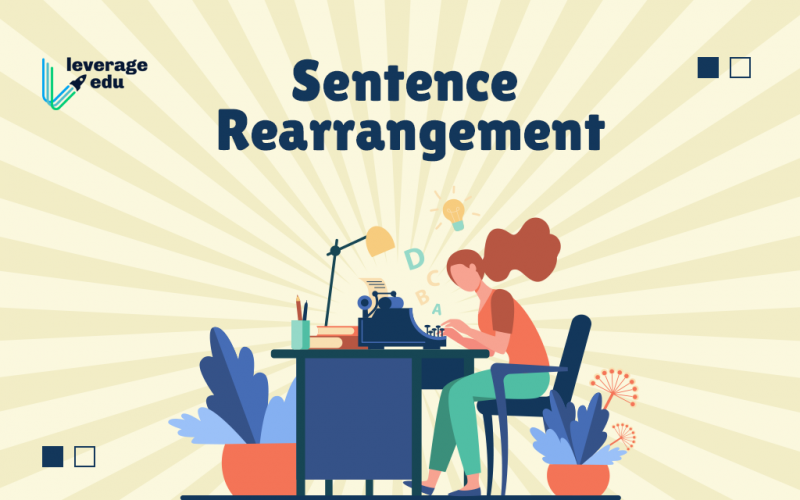Sentence Rearrangement questions are often asked in bank exams as well as covered under the English syllabus for Class 9 and Class 10. But what does sentence rearrangement mean? As the words suggest, it simply asks the test-taker to re-arrange sentences in a meaningful manner. While appearing for competitive exams as well as government exams, you will come across such questions that require putting different sentences in a concise and coherent paragraph that makes sense. Often referred to as para-jumbled sentences, there is no specific topic of all the sentence rearrangement and it can be on any topic. Let’s practice sentence rearrangement for bank exams and understand some useful tricks and tips that can help you ace this topic!
Also Read: Check Out Our Cheatsheet to English for Bank Exams!

Types of Sentence Rearrangement
To solve sentence rearrangement questions efficiently, there are four types of variations that you must know about:
- In the basic first type of sentence rearrangement, 4-5 sentences will be provided in jumbled-up form & all the applicants have to rearrange them in the correct sequence.
- In the second variation, the first sentence will be fixed & other sentences will have to be arranged in a way that the first sentence doesn’t move & the whole paragraph is relevant.
- This is another form of sentence rearrangement in which there is a fixed sentence and the remaining sentences have to rearrange logically that the constant sentence doesn’t move from its designated place in the paragraph.
- The fourth variation is a mixture of the second & third ones. In this variation, the first & last sentences are constant & other sentences have to be rearranged.
Also Read: Practice Jumbled Words Questions here!
Sentence Rearrangement Tricks
Sentence rearrangement is a scoring topic in competitive exams but if not practised well, it can be a bit confusing & time-consuming. Here are some useful sentence rearrangement tricks and toppers that you use to crack this topic!
- Read the jumbled sentences with proper focus and at least twice. This will help you to identify the theme of the paragraph and thus it will be easier to arrange the sentences afterwards.
- Sometimes the first sentence is constant, this makes it easy to identify the sequence of the lines. In case there are no starting sentences, you have to identify the first sentence. You can also opt for the elimination method by removing the wrong choices and from the remaining sentences choose the correct one.
- Always remember most of the sentences will start with a fact, issue, idea, narration, quote.
- After fixing your first sentence, move on to the body of the paragraph. It should mainly include more information about the topic, issues, or problems.
- To complete the whole paragraph you will need a conclusion. The last sentences will include feedback, comment, suggestions, etc.
- It is always advised to connect one sentence to another, connecting the dots will help you to solve the sentence rearrangement easily.
Also Read:English Grammar Tenses Rule with Examples
Sentence Rearrangement Practice Questions
Here are some of the sentence rearrangement questions that you can practice. The mentioned questions are from various bank examinations.
Directions: In questions given below, a sentence is given which is divided into FOUR parts such that the parts are jumbled and do not make a meaningful sentence. Rearrange the following parts to form a grammatically correct and meaningful sentence and choose the correct rearrangement from the options given below each question.
- Scientists have discovered (A)/ that may pave way for sustainable ways to clean up oil spills (B)/a unique oil-eating bacteria in the Mariana Trench, the (C)/deepest part of the earth’s oceans, a finding (D). (SBI PO 2019)
- CDBA
- BCDA
- ACDB
- ADCB
- DCBA
Answer: 3
- Andhra Pradesh on Monday morning (A)/ EMISAT, from Sriharikota in coastal (B)/ the Indian Space Research Organisation (ISRO) launched (C)/the country’s first electronic surveillance satellite (SBI PO 2019)
- CDBA
- BCDA
- ACDB
- ADCB
- DCBA
Answer: 1
- (A) concept used when
(B) philosophy of technology
(C) technological somnambulism is a
(D) talking about the
(IBPS Exam 2019)- CADB
- ABCD
- BCDA
- ADCB
- CABD
Answer: 1
- (A) with the interim budget out,
(B) all eyes are now on the Monetary
(C) policy Committee’s (MPC) decision that
(D) will be announced on 7 February (IBPS Exam 2019)- CADB
- ABCD
- BCDA
- ADCB
- CABD
Answer: 1
- Answer the following questions after rearranging the following sentences into a coherent paragraph and identify the sentence that doesn’t fit in the context of the paragraph. (IBPS Clerk Main Exam 2018)
(A) While there indeed are structural impediments (posed by both India and its neighbours) in fostering regional integration, the most significant handicap is New Delhi’s ideational disinclination towards its neighbourhood.
(B) Unfortunately, those of us who value religious freedom have been disillusioned by multiple governments once too often.
(C) Successive regimes have considered the neighbourhood as an irritant and challenge, not an opportunity.
(D) If South Asia is one of the world’s least integrated regions, India is one of the world’s least regionally integrated major powers.
(E) Today, we have become even more transactional, impatient, and small-minded towards our neighbourhood which has, as a result, restricted our space for manoeuvre in the regional geopolitical scheme of things
(F) Seldom have India’s policies displayed a sense of belonging to the region or a desire to work with the neighbourhood for greater integration and cooperation.- Considering the statement (D), “If South Asia is one of the world’s least integrated regions, India is one of the world’s least regionally-integrated major powers.” as the FIRST statement of the paragraph after the rearrangement, which one among the following pairs is consecutively related with each other?
- A-C
- D-C
- C-E
- D-F
- A-F
- Considering the statement (D), “If South Asia is one of the world’s least integrated regions, India is one of the world’s least regionally-integrated major powers.” as the FIRST statement of the paragraph after the rearrangement, which one among the following pairs is consecutively related with each other?
Answer: 1

Sentence Rearrangement Practice Questions PDF
Must Read: English for Competitive Exams
FAQs
Sentence rearrangement questions range from 5 to 10 marks, varying as per the test you are appearing for.
Yes, sentence rearrangement questions are also referred to as para-jumbled sentences.
Most of the time, the whole paragraph has the same theme thus it is always advised to connect the sentences it makes it easier to understand and solve.
Yes, SBI PO exam comprises sentence rearrangement in the section of English Language.
No, these two are different because the former focuses on arranging sentences while the latter is more about the omission of words in a sentence. To know more, check out Cloze Test!
We hope this blog on sentence rearrangement helped you understand this topic as well as practice important questions. Preparing for English proficiency exams like IELTS or TOEFL? Sign up for a free demo session with our Leverage Live experts and take the first step towards your standardised test preparation!

 One app for all your study abroad needs
One app for all your study abroad needs




















 45,000+ students realised their study abroad dream with us. Take the first step today.
45,000+ students realised their study abroad dream with us. Take the first step today.

